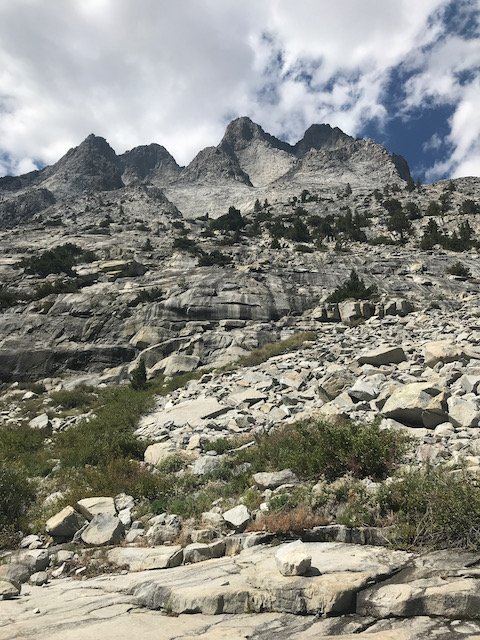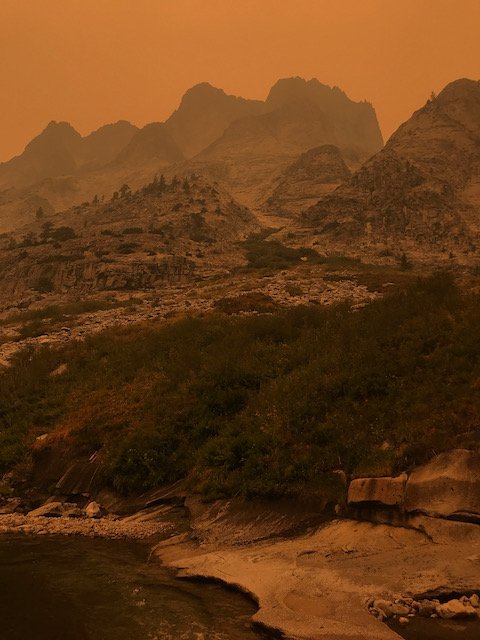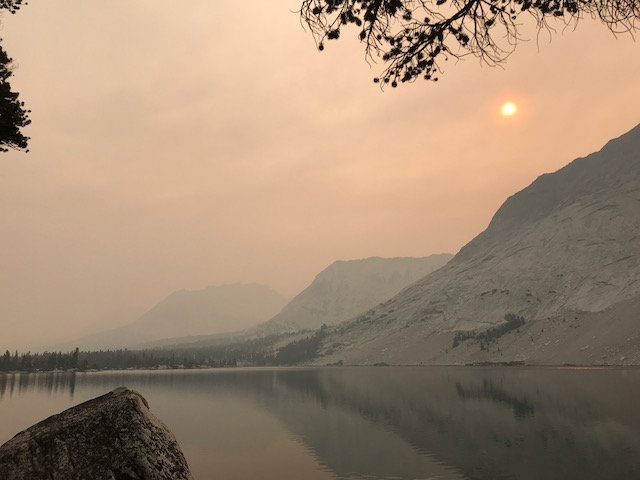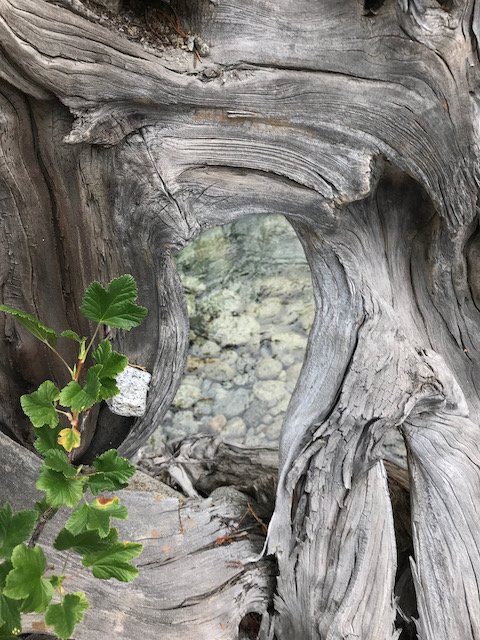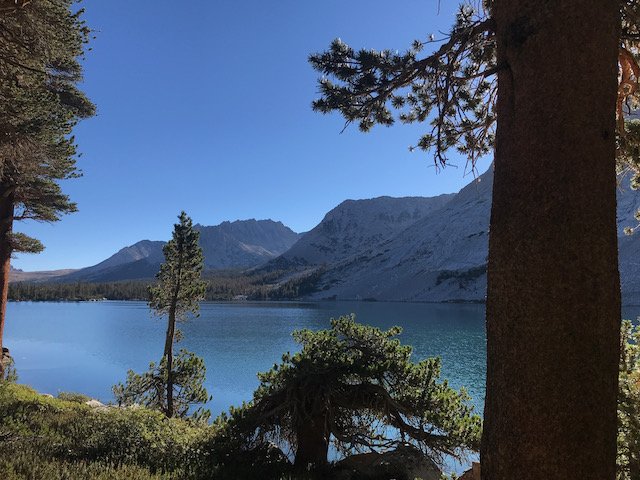Burning Mental Impressions: Writings From the Backcountry
Written by Dennis Eagan, WildYoga Founder & Lead Trainer for Balanced Rock’s WildYoga Advanced Studies Program.
September 7, 2020 | Bench Lake, Kings Canyon National Park
Thick smoke had infiltrated the high country during the night, turning the tent into a claustrophobic prison with its nylon walls closing in on me. I crawled out of the sleeping bag, dressed, and stepped out the door into ash raining from a burnt sky. Smoke is common in the High Sierra in late summer and fall, but I had never seen it this bad at 10,600. Little did I realize that twenty miles to the north, the National Guard was rescuing one hundred sixty hikers by helicopter from the projected path of the Creek Fire—the largest single wildfire in California’s history. It would burn for months, force forty-five thousand people to evacuate their homes, destroy over eight hundred fifty structures, and scorch more than a third of a million acres.
I got to get out of here, I thought, but which way? The sky’s uniform tint left no clue as to the fire’s direction. A suppressed panic washed over me. I fired up the Jetboil and made a cup of coffee to ponder my predicament.
“Smoke is common in the High Sierra in late summer and fall, but I had never seen it this bad at 10,600. Little did I realize that twenty miles to the north, the National Guard was rescuing one hundred sixty hikers by helicopter from the projected path of the Creek Fire—the largest single wildfire in California’s history.”
The second aphorism of Patanjali’s Yoga Sutra— Yoga chitta vritti narodaha— tells us that the mind is the cause of suffering. The classic definition: yoga is the cessation of the fluctuations of the mind. I often struggle with a world and country that are much different than my vision of what they could be. This year more than ever, a global pandemic, racial injustice, climate change, and dysfunctional politics have made the backcountry a precious refuge. But now with the entire West burning, even the wilderness felt suffocating.
In yoga philosophy, Agni—the Hindu fire god—expresses his energy through the sun, lightning, and the sacrificial flame. He transforms things through intensity. There is no escaping his fury here in the West’s fire-ecology where blazing forests and smoke filled skies have haunted people for thousands of years. But Agni has a benevolent side. He is also the campfire’s warmth on a chilly night and the breath in the wood stove that heats the home. Fire shapes our sylvan landscape, awakening seedlings stored in the soil by melting their resin coating. Aspen, lodgepole pine, and the largest living beings on Earth—Giant Sequoias—are all born of fire. Sequoias are Agni’s trees. He has blessed them with fibrous, fire-resistant bark up to two feet thick that allows them to survive even the hottest burns and to live for up to three thousand years. Other forest plants only germinate through changes in soil chemistry driven by smoke, ash, and char. Agni presents the ultimate dichotomy: life and death.
The Creek Fire had started three days earlier, the same day I left the trailhead at Road’s End in King’s Canyon National Park with six days of food. I’d almost canceled the trip due to the lousy air that had been eddying around California for the past couple of weeks due to the SQF Complex Fire burning in the southern part of Sequoia National Park and the nearly four hundred other fires raging across the state. But that first morning, a clear blue sky gave the green light. My luck held the following day when I made my way up Arrow Creek and over Arrow Pass to my camp here at Bench Lake.
Yesterday, as I scrambled up Arrow Peak’s northeast arete, my throat began to feel scratchy. The daily upslope breeze had pushed smoke up from the foothills and Central Valley all the way to 13,000 feet. Evening’s cool air shoved most of this haze back down. But then around 6:30 p.m., an ominous black wave of smoke began to creep in from the northwest, over the Monarch Divide. Within minutes it had blotted out the sun.
Now I was looking at a twenty-plus-mile hike out of the backcountry while sucking air that contained enough particulate matter to qualify as hazardous on the AQ Index. My intended route back to the car was the most direct and all downhill, but if this new fire was burning up that drainage, I would be walking right into it. Should I go south or north on the John Muir Trail? Exit the mountains to the east or west? I hadn’t seen anyone since I left the trail in Paradise Valley and started bushwhacking up Arrow Creek two days ago. There was no one to consult. Most sensible people were staying indoors and avoiding strenuous exercise.
Though it would require a dozen miles of off-trail travel, I decided to stick with my original plan: follow the South Fork of the King’s River downstream to Paradise Valley and catch the Woods Creek Trail out. Every other option would have required climbing a couple of thousand feet over a pass. At least going downhill, I’d avoid breathing hard and stressing my lungs more than necessary. I’d know within a few hours of committing to the canyon whether or not my decision was the right one.
Then something remarkable happened once I began to move: my mind shifted from melancholia to wonder. I stopped obsessing about survival and started focusing on route finding. I found myself once again enjoying the backcountry solitude and the beauty around me in spite of the oppressive smoke. My agenda–the peaks I had hoped to climb–faded away. Since the trip was ending early and the trailhead lay only two days away, I had plenty of food and no need to rush. Over the next eight hours, a magical day unfolded as I made my way downstream through forest and meadows, boulder-hopping across talus fields or in the riverbed. I noticed the tangerine glow of sunlight dancing on the river, a stone face where water had carved three perfectly round potholes in the granite, amber trunks of cedar trees growing out of snow-white cobbles, and a tortoise-shaped boulder. I saw the earth as it was, not as I wanted it to be. Smooth slabs, crystal clear pools, and stair-stepping cascades all appeared quite lovely in the rusty light.
According to the Prthivi Sutkta of the Atharva Veda, one of Hinduism oldest text, “Agni flows through all creatures in the form of hunger.” Jatar agni, the fire of digestion, converts food to fuel. On the emotional level: rage must have burned in the hearts of the vigilantes under Major John Savage in 1850 when they attacked an Ahwahnechee village on December 8th, set fire to the natives’ pine huts with embers from their own campfires, and drove the indigenous people from their home in Yosemite Valley… and left a black scar on the beginning of the modern conservation movement. Psychologically, bauddhika agni burns mental impressions. It seemed Agni had changed my mind? What should have been one of the most miserable backcountry days of my life was turning out to be a delightful wander though the wild.
I don’t take climate change and the devastation of our western forests lightly. Like many people, I suffer from solastalgia—the term for a psychic affliction first coined by Professor Glenn Albrecht of the University of New Castle, Australia—the existential grief of habitat loss.
Albrecht describes solastagia as “the homesickness you have when you are still at home,’’ due to environmental changes. My home lies in the Sierra Nevada foothills where oak, pine, and manzanita mingle. I hike, ski, and climb these mountains, kayak the rivers, and often, just sit and stare at the landscape and scope critters through binoculars. The entire range is my home, But hotter and longer summers, beetle infestation, and multi-year drought have turned the Sierra’s forest floor into a powder keg that I sit on through each fire season, hoping and praying that Agni will spare me, my home, my community, these mountains, this canyon, and all the creatures in it.
But in the face of environmental degradation resulting from climate change, my sense of connection to and appreciation for the natural world only deepens. Solastalgia does not stand alone, in fact, it only exists because of biopilia—love of life. E.O. Wilson—the world’s leading expert on ants, who has been called the father of sociobiology and the father of biodiversity—defines the word as “the innate tendency to focus on life and lifelike processes… our existence depends on this propensity, our spirit is woven from it, hope rises on its currents.” It’s an emotion I felt long before my wife, Andie, introduced me to these two concepts. I remember the anguish I felt as an eight-year-old in Los Angeles when my father washed down an army of ants that had invaded our kitchen sink. I cried and begged him to stop drowning the poor insects… as if I were going down the drain with them. My love of nature comes with a cost; one I’m willing to pay.
When I went to bed that night under a thick smoke ceiling, I could barely see the canyon walls a few hundred yards away. Feathery wisps of ash drifted down from the sky to rest upon the sleeping bag. In contrast to the impending sense of doom that I had experienced at the beginning of the day, I felt blessed to be there at that moment, realizing this canyon or at least every living thing in it could be torched soon. I no longer take for granted that a wild place I visit will remain the same.
Dennis Eagan began practicing yoga in 1989 and has been teaching since 1998.
As founder of Wild Yoga, he weaves nearly four decades of wilderness guiding and study into teacher training courses, workshops, and wilderness yoga retreats throughout the west from Baja to Alaska.
You can learn more about Dennis by visiting his website: www.wildyoga.com
All photos provided by Dennis Eagan.


